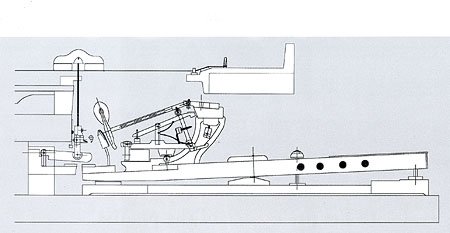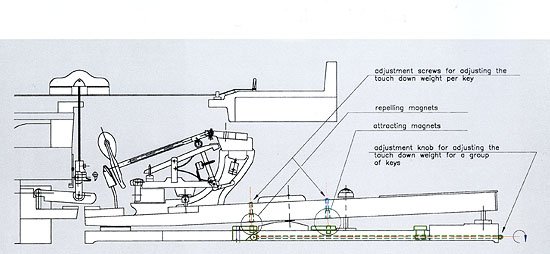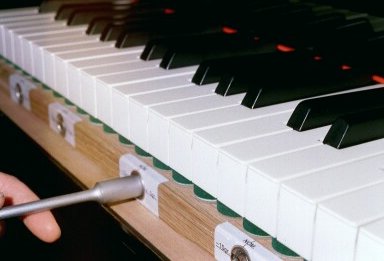The Magnetic Balance Action
 The Magnetic Balance Action is a major development in piano action design. It has been received with great enthusiasm and praise from Professional Pianists and was designed by Evert Snel and Hans Velo in Holland. The Magnetic Balance Action is a major development in piano action design. It has been received with great enthusiasm and praise from Professional Pianists and was designed by Evert Snel and Hans Velo in Holland.
Bert van den Brink:
“From now on, easy or light playing is no longer the same as weak and unpredictable playing; on the contrary, the keys stick to your fingers regardless of the chosen touch-weight.”
Paul Komen:
“The complete absence of inertia, especially in the bass register, is quite spectacular. This gives a lightness and directness that I have never before encountered in a piano. The sensitivity of response makes possible the finest nuances, making this action the ideal tool for one to approach ones ideal sound. In my opinion, this is the most important invention in the piano action since Erards double repetition action. It merits widespread application.”
Rian de Waal:
“With this letter I would like to express my enthusiasm with the magnet action. The magnet action is a fantastic improvement as it allows the pianist literally to play with the touch-weight of the keys. On days when you have to practice for eight hours, the touch is as light as possible; on days when Brahms First, or Rachmanninov Third is on the music reading desk, a touch-weight as heavy as possible is there to train the muscles. Its ideal!”
Martijn van den Hoek:
“This action showed an easy-to deal-with" quality, with the possibility of a direct adaptation within shortest possible time. When I was informed about the details and additional possibilities, that can be derived from these, i.e. the quick adjustment of the key weight and the easy maintaining of it, I truly felt that this might be a real contribution to the, more or less perfection piano as we know it today.
The Magnetic Balance Action
During the course of the development of the piano in the 19th and 20th centuries, the introduction of the iron frame allowed for hammer weight and string tension to be increased. This has enabled the pianist to play using a wider range of soft to loud volume.
The increase in hammer weight put enormous physical demands on the pianist’s fingers to depress the heavy keys. To keep the touch weight light, the practice developed of inserting lead weights to the front-end of the key, when the touch weight was too heavy and in the rear-end of the key, if the touch weight is too light.
For example in the bass section of the modern grand piano the touch weight, without lead in the
key, can be 95 grams. In order to get a touch weight of 52 grams, a considerable amount of lead weights must be placed in the front end of the key.
The new Magnetic Balanced Action
The new MBA action uses a system with magnets to equalise the touch weight of the piano keys. In short, there are two opposite polarity (attracting) magnets at the front end of the key, counter-balanced by two same polarity (repelling) magnets at the rear end of the key. This is made possible by the development of modern magnet materials.
 The Magnetic Balance Action has many advantages over using lead weights. The Touch weight of the keys can quickly and easily be altered to individual personal preferences. This can be very useful for the serious pianist who wishes to rapidly develop Technique. The Magnetic Balance Action has many advantages over using lead weights. The Touch weight of the keys can quickly and easily be altered to individual personal preferences. This can be very useful for the serious pianist who wishes to rapidly develop Technique.
As an example the serious athlete will go to the Gymnasium to build strong muscles, like wise for the pianist to rapidly develop a fine technique weight lifting exercises for the fingers hand arms and body will need to be done. With the Magnetic Balance Action Key weight can be adjusted to heavy for doing exercises but can be reduced when the pianist wishes to relax from gruelling training.
The Mathematics; Geometry; Physics and engineering are highly complex to explain and to understand, but in short Pianissimo (soft Playing) and fast repetition (key return) can be achieved with greater ease and control with the use of magnets as apposed to lead weights in the keys. This system can be very useful in concert halls where there will be different people playing the piano, all having different requirements. Also long term strain and damage to the pianist’s hands can also be greatly reduced.
 Adjusting The Magnetic Balance Action Adjusting The Magnetic Balance Action
It is very easy to adapt the touch-weight quickly to the personal preferences of the pianist. In fact, the pianist can do it themselves by manipulating a number of adjustment controls at the front of the instrument. The touch-weight can be adjusted from +5 grams in relation to the nominal weight, to 10 grams in relation to the nominal weight. In the latter case, the touch-weight is reduced by about 20 per cent.
Telephone: +44 (0) 845 0703833 / +44 (0) 1579 370423
|